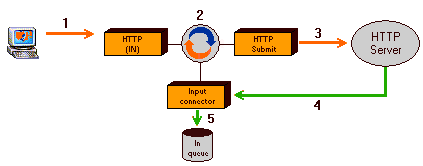These connectors enable the StreamServer to function as an HTTP client submitting output to an HTTP server.
|
Use the HTTPS Submit connector if you want the StreamServer to function as an SSL client that communicates over an encrypted HTTPS channel.
|
Select whether to use a security configuration or a CA certificate for the HTTPS Submit connector. If the HTTPS server requires client authentication, you must use a security configuration. If the HTTPS server does not require client authentication, you can use a CA certificate instead.
The CA root certificate that confirms the identity of the SSL server. See the Encryption and authentication documentation for more information about security configurations. The certificate must be included in a resource set connected to the Platform.
The Security configuration to use with the HTTPS Submit connector. See the Encryption and authentication documentation for more information. The security configuration must be included in a resource set connected to the Platform.
|
•
|
POST – Send output to the HTTP server for further processing.
|
|
•
|
PUT – Send output to the HTTP server. For example, if output is a web page, select PUT to put it on a web server. Requires scripting and specific access rights to the server.
|
|
Example 20
|
text/html; charset="ascii"
The SSL version to use with the HTTPS Submit connector. The server and the clients must use the same SSL version.
The type of authentication scheme (RFC 2617) to use for password authentication.
|
•
|
None - Do not use authentication.
|
|
•
|
Basic - Send authentication parameters as clear text. This is the only scheme supported in HTTP/1.0.
|
|
•
|
Digest - Send authentication parameters as a checksum over the network. Requires HTTP/1.1.
|
Name:Value
The name of the connector that receives the response from the HTTP server. Used only if a response is required. This connector is either an HTTP Response output connector, or any type of queue enabled input connector.
|
5
|
The HTTP connector retrieves the response from the HTTP Response connector, and sends it to the client.
|
Name:Value
The connector that retrieves the On failure file specified above. This connector is either an HTTP Response output connector, or any type of queue enabled input connector. For example, if the StreamServer receives input from a client, and sends output to an HTTP server, an error message (the on failure file) can be sent back to the client via an HTTP Response connector.
|
3
|
The StreamServer tries, but fails, to send the processed data via an HTTP Submit connector to an HTTP server.
|
|
5
|
The HTTP connector retrieves the On failure file from the HTTP Response connector, and sends it to the client.
|
|
3
|
The StreamServer tries, but fails, to send the processed data via an HTTP Submit connector to an HTTP server.
|
|
Example 25
|
text/html; charset="ascii"
Name:Value




